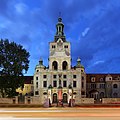
The Victoria and Albert Museum in London is the world's largest museum of applied arts, decorative arts and design, housing a permanent collection of over 2.8 million objects. It was founded in 1852 and named after Queen Victoria and Prince Albert.

The Wallace Collection is a museum in London occupying Hertford House in Manchester Square, the former townhouse of the Seymour family, Marquesses of Hertford. It is named after Sir Richard Wallace, who built the extensive collection, along with the Marquesses of Hertford, in the 18th and 19th centuries. The collection features fine and decorative arts from the 15th to the 19th centuries with important holdings of French 18th-century paintings, furniture, arms and armour, porcelain and Old Master paintings arranged into 25 galleries. It is open to the public and entry is free.

Tilman Riemenschneider was a German woodcarver and sculptor active in Würzburg from 1483. He was one of the most prolific and versatile sculptors of the transition period between the Late Gothic, to which he essentially belonged, and Northern Renaissance art, a master in limewood and stone. He was also a local politician in the council of Würzburg.

Walters Art Museum is a public art museum located in the Mount Vernon section of Baltimore, Maryland. Founded and opened in 1934, it holds collections from the mid-19th century that were amassed substantially by major American art and sculpture collectors, including William Thompson Walters and his son Henry Walters. William Walters began collecting when he moved to Paris as a nominal Confederate loyalist at the outbreak of the American Civil War in 1861, and Henry Walters refined the collection and made arrangements for the construction what ultimately was Walters Art Museum.
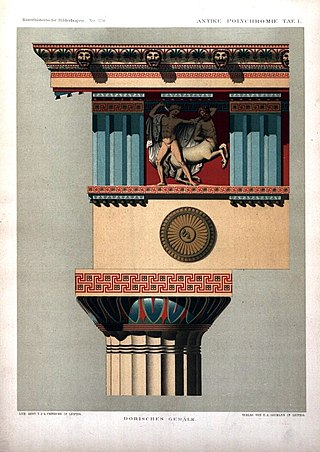
Polychrome is the "practice of decorating architectural elements, sculpture, etc., in a variety of colors." The term is used to refer to certain styles of architecture, pottery, or sculpture in multiple colors.

Schatzkammer, a German word which means "treasury" or "treasure chamber", is a term sometimes used in English for the collection of treasures, especially objets d’art in precious metals and jewels, of a ruler or other collector which are kept in a secure room and often found in the basement of a palace or castle. It also often included the wider types of object typical of the Renaissance cabinet of curiosities. A very small but evocative Renaissance room in a tower at Lacock Abbey was designed for keeping and viewing the treasures of the newly rich owner.

The Germanisches Nationalmuseum is a museum in Nuremberg, Germany. Founded in 1852, it houses a large collection of items relating to German culture and art extending from prehistoric times through to the present day. The museum is Germany's largest museum of cultural history. Out of its total holding of some 1.3 million objects, approximately 25,000 are exhibited.

The Residenz in central Munich is the former royal palace of the Wittelsbach monarchs of Bavaria. The Residenz is the largest city palace in Germany and is today open to visitors for its architecture, room decorations, and displays from the former royal collections.
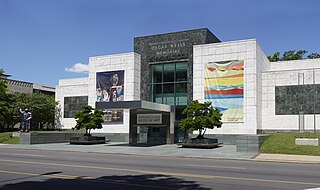
The Birmingham Museum of Art is a museum in Birmingham, Alabama. Its collection includes more than 24,000 paintings, sculptures, prints, drawings, and decorative arts representing various cultures, including Asian, European, American, African, Pre-Columbian, and Native American. The museum is also home to some Renaissance and Baroque paintings, sculptures,and decorative arts from the late 13th century to c. 1750.

Trausnitz Castle is a medieval castle situated in Landshut, Bavaria in Germany.

The Museum Five Continents or Five Continents Museum, located in Munich, Germany, is a museum for non-European artworks and objects of cultural value. Its name until 9 September 2014 was Bavarian State Museum of Ethnology.

The Bode Museum, formerly called the Kaiser-Friedrich-Museum, is a listed building on the Museum Island in the historic centre of Berlin. It was built from 1898 to 1904 by order of German Emperor William II according to plans by Ernst von Ihne in Baroque Revival style. The building's front square featured a memorial to German Emperor Frederick III, which was destroyed by the East German authorities. Currently, the Bode-Museum is home to the Skulpturensammlung, the Museum für Byzantinische Kunst and the Münzkabinett. As part of the Museum Island complex, the Bode-Museum was inscribed on the UNESCO World Heritage List in 1999 because of its outstanding architecture and testimony to the development of museums as a cultural phenomenon in the late 19th and early 20th centuries.
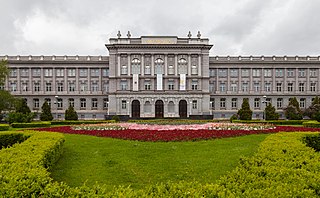
The Mimara Museum is an art museum in the city of Zagreb, Croatia. It is situated on Roosevelt Square, housing the collection by Wiltrud and Ante Topić Mimara.

The Nymphenburg Porcelain Manufactory is located at the Nördliches Schloßrondell in one of the Cavalier Houses in front of the Nymphenburg Palace in Munich, Germany, and since its establishment in 1747 has produced porcelain of high quality. It is one of the last porcelain producers in the world where every single part is made entirely by hand.

The Museum of Art, Rhode Island School of Design is an art museum integrated with the Rhode Island School of Design, in Providence, Rhode Island, US. The museum was co-founded with the school in 1877. It is the 20th-largest art museum in the United States, and has seven curatorial departments.

The Bavarian State Painting Collections, based in Munich, Germany, oversees artwork held by the Free State of Bavaria. It was established in 1799 as Centralgemäldegaleriedirektion. Artwork includes paintings, sculptures, photographs, video art and installation art. Pieces are on display in numerous galleries and museums throughout Bavaria.
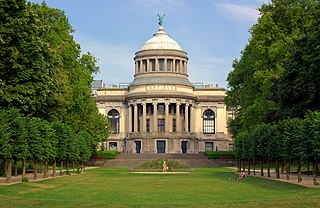
The Art & History Museum is a public museum of antiquities and ethnographic and decorative arts located at the Parc du Cinquantenaire/Jubelpark in Brussels, Belgium. The museum is one of the constituent parts of the Royal Museums of Art and History (RMAH) and is one of the largest art museums in Europe. It was formerly called the Cinquantenaire Museum until 2018. It is served by the metro stations Schuman and Merode on lines 1 and 5.

The Museum für Kunst und Gewerbe Hamburg is a museum of fine, applied and decorative arts in Hamburg, Germany. It is located centrally, near the Hauptbahnhof.

The Museum für Angewandte Kunst Köln is a decorative arts museum in Cologne. The collections include jewellery, porcelain, furniture, weaponry and architectural exhibits. Until 1987 it was called the Kunstgewerbemuseum.
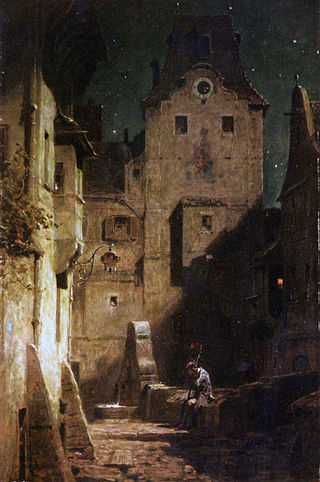
The Kurpfälzisches Museum is a museum of art and archaeology in Heidelberg, Germany. It is located in the Palais Morass. It was founded in the late 1870s, when the city of Heidelberg purchased the private collection of the artist and art historian Charles de Graimberg.








